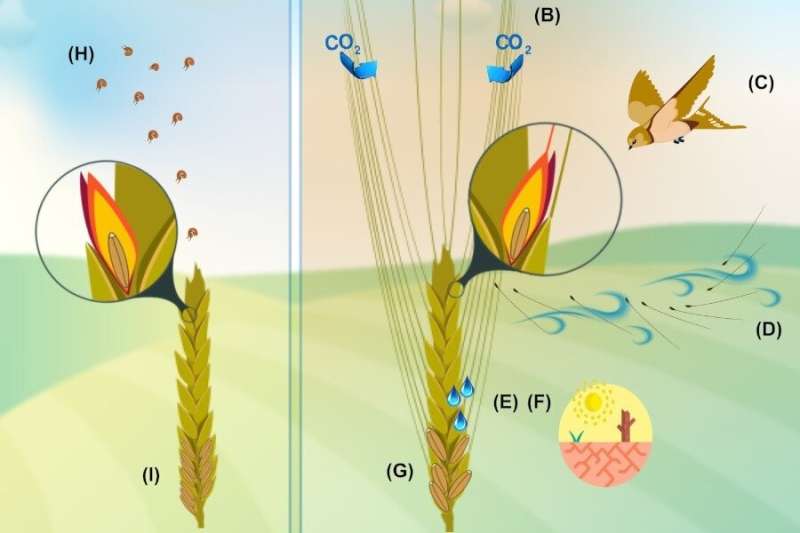This article has been reviewed according to Science X's editorial process and policies. Editors have highlighted the following attributes while ensuring the content's credibility:
fact-checked
peer-reviewed publication
trusted source
proofread
Tracing the evolution of wheat spikes since the Neolithic revolution

About 12,000 years ago, the Neolithic revolution radically changed the economy, diet and structure of the first human societies in the Fertile Crescent of the Near East. With the beginning of the cultivation of cereals, such as wheat and barley, and the domestication of animals, the first cities emerged in a new social context marked by a productive economy.
Now, a study published in the journal Trends in Plant Science and co-led by the University of Barcelona, the Agrotecnio center and the University of Lleida, analyzes the evolution of wheat spikes since its cultivation began by the inhabitants of ancient Mesopotamia—the cradle of agriculture in the world—between the Tigris and the Euphrates rivers.
The authors of the study are Rut Sánchez-Bragado and Josep Lluís Araus-Ortega, from the UB Faculty of Biology and Agrotecnio-UdL; Gustavo A. Slafer, ICREA researcher at the UdL School of Agrifood and Forestry Science and Engineering, and Gemma Molero, from the International Maize and Wheat Improvement Center in Mexico, currently a researcher at KWS Seeds Inc.
A cereal that changed human history
The cultivation of wheat, a grass that became basic food, represented a turning point in the progress of human civilization. Today it is the world's most important crop in terms of food security, but EU data warn that the impact of climate change could significantly increase its price and modify its production process in certain areas of the world.
Throughout the domestication process of wheat, the plant phenotype has undergone both rapid (within a few hundred years) and slow (thousands of years) changes, such as the weakening of the rachis, the increase in seed size, and the reduction or disappearance of the awns. In particular, awned and awnless wheat varieties are found all over the world, although the latter tend to be abundant in regions with arid climates, especially during the final stages of cultivation in late spring, a condition typical of Mediterranean environments.
"It is important to conduct studies that show which wheat varieties are best adapted to different environmental growing conditions, especially in a context of climate change. Studying the past retrospectively can give us an idea of the evolution of wheat cultivation over the millennia since agriculture appeared in ancient Mesopotamia," says Rut Sánchez-Bragado, first author of the study, who got a Ph.D. at the UB.
"Awns are organs of the spike that have traditionally been associated with the plant's adaptations to drought conditions," says Josep Lluís Araus, professor at the Department of Evolutionary Biology, Ecology and Environmental Sciences of the Faculty of Biology.
"However, archaeological and historical records show that the wheat spike has existed predominantly with awns for more than ten millennia after the domestication of wheat. It is not until the last millennium that evidence shows in many cases the absence of awns, indicating a selection by farmers—probably in an undirected way—against this organ," says Araus.
"The role of wheat awns in their performance remains controversial despite decades of studies," says researcher Gustavo A. Slafer, corresponding author of the study.
Spike awns: Beneficial for the plant?
Is the presence of awns on the spike beneficial for the plant and the crops? Although there is no scientific consensus, "Everything suggests that in conditions where the plant does not suffer from water stress, the extra photosynthetic capacity of the awns does not compensate for other potential negative effects (reduced susceptibility to fungal diseases, limitation in the total number of large ones that an ear supports, etc.)," says Araus.
"However, in wetter climates the awns accumulate moisture and can promote the spread of diseases," says Rut Sánchez-Bragado. "So, as the world's population is continuously growing, it is necessary to investigate the role of the awned spikes in the changing conditions of our climate in order to meet the world's demand for a primary food commodity such as wheat."
In arid conditions, the spikes—including the awns—"have better physiological characteristics than the leaves. In addition, the awns allow the light captured by the crop to be more diffused, which facilitates a better distribution of light energy and allows the crop to photosynthesize more. Therefore, in arid conditions, the awns can still be beneficial for the crop, or at most, neutral," concludes Professor Josep Lluís Araus.
More information: Rut Sanchez-Bragado et al, Awned versus awnless wheat spikes: does it matter? Trends in Plant Science (2022). DOI: 10.1016/j.tplants.2022.10.010
Journal information: Trends in Plant Science
Provided by University of Barcelona





















